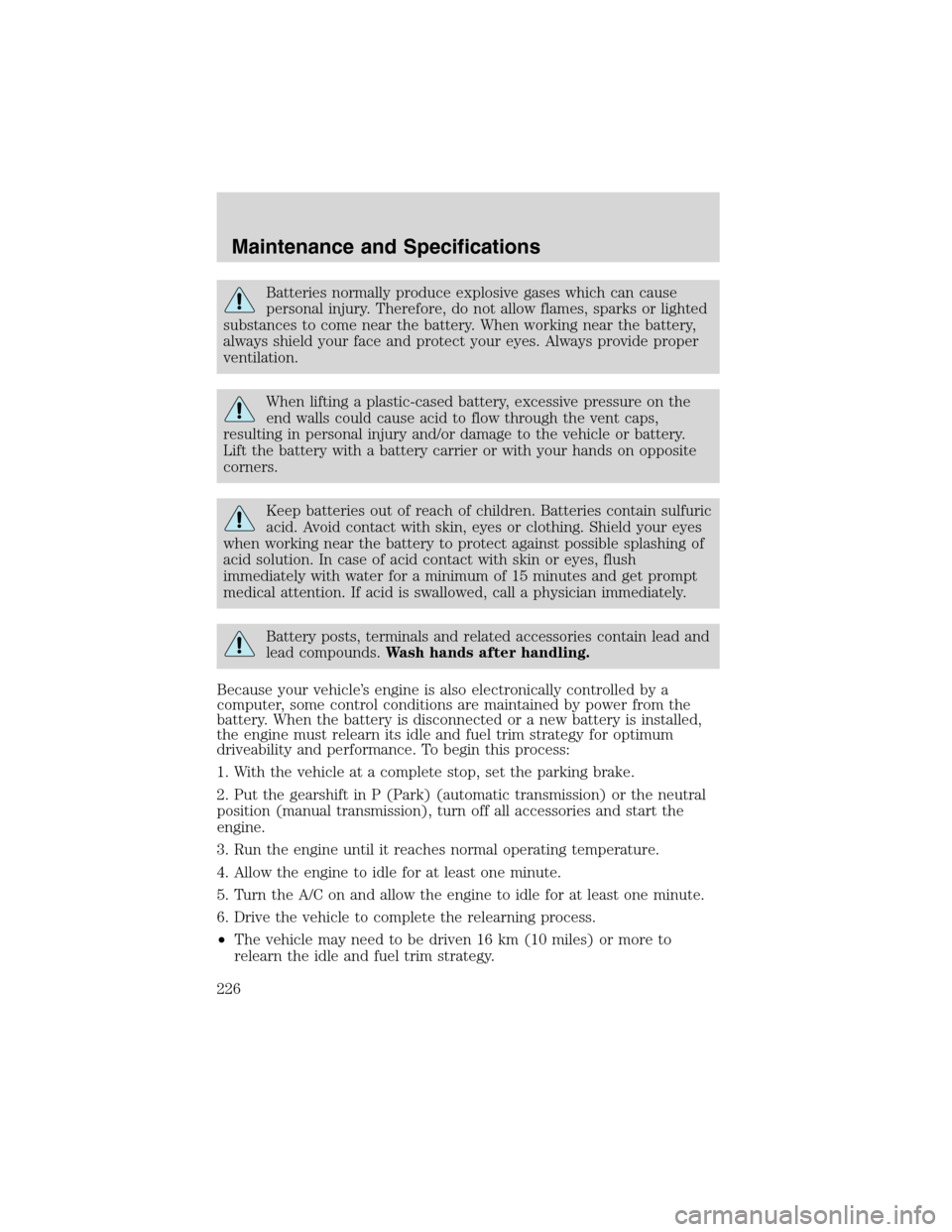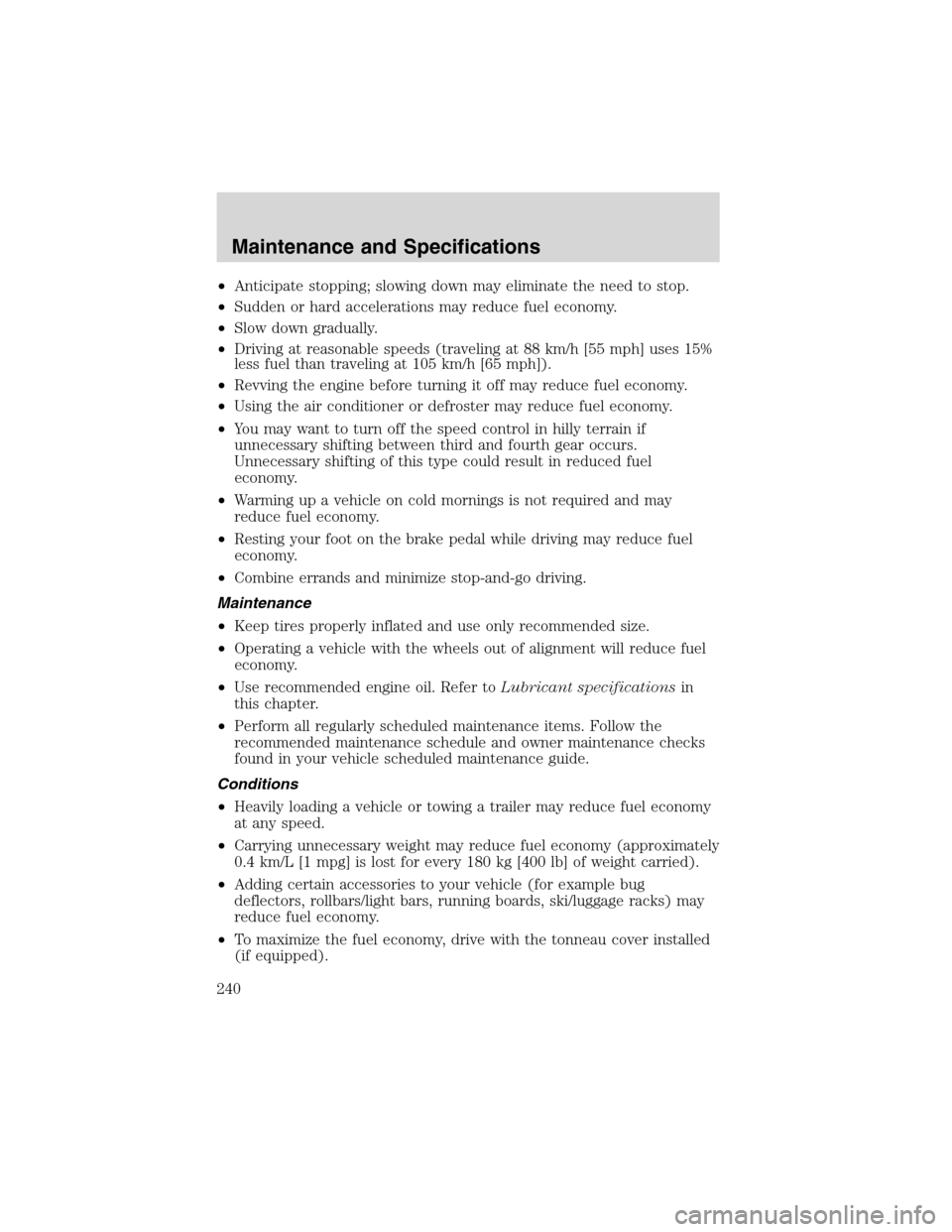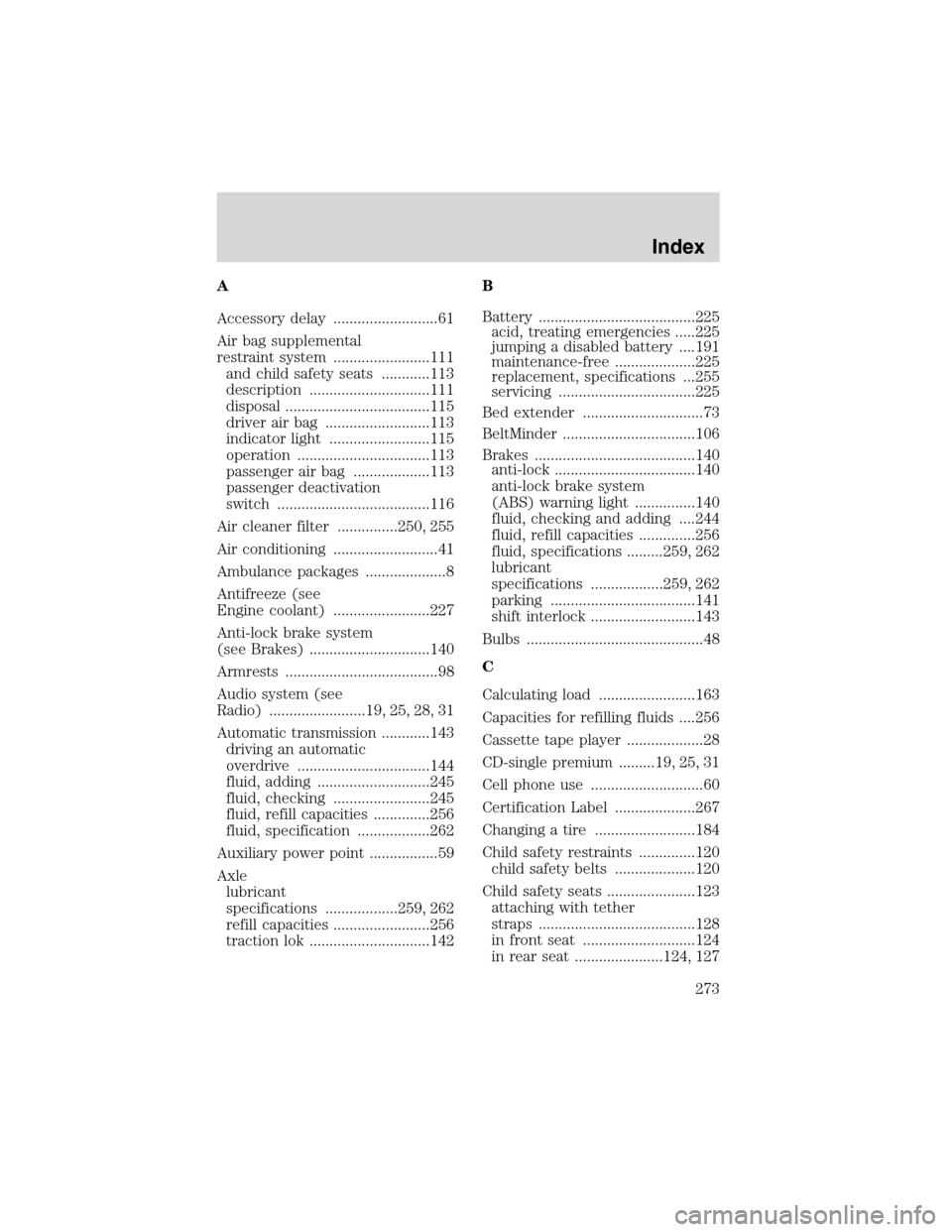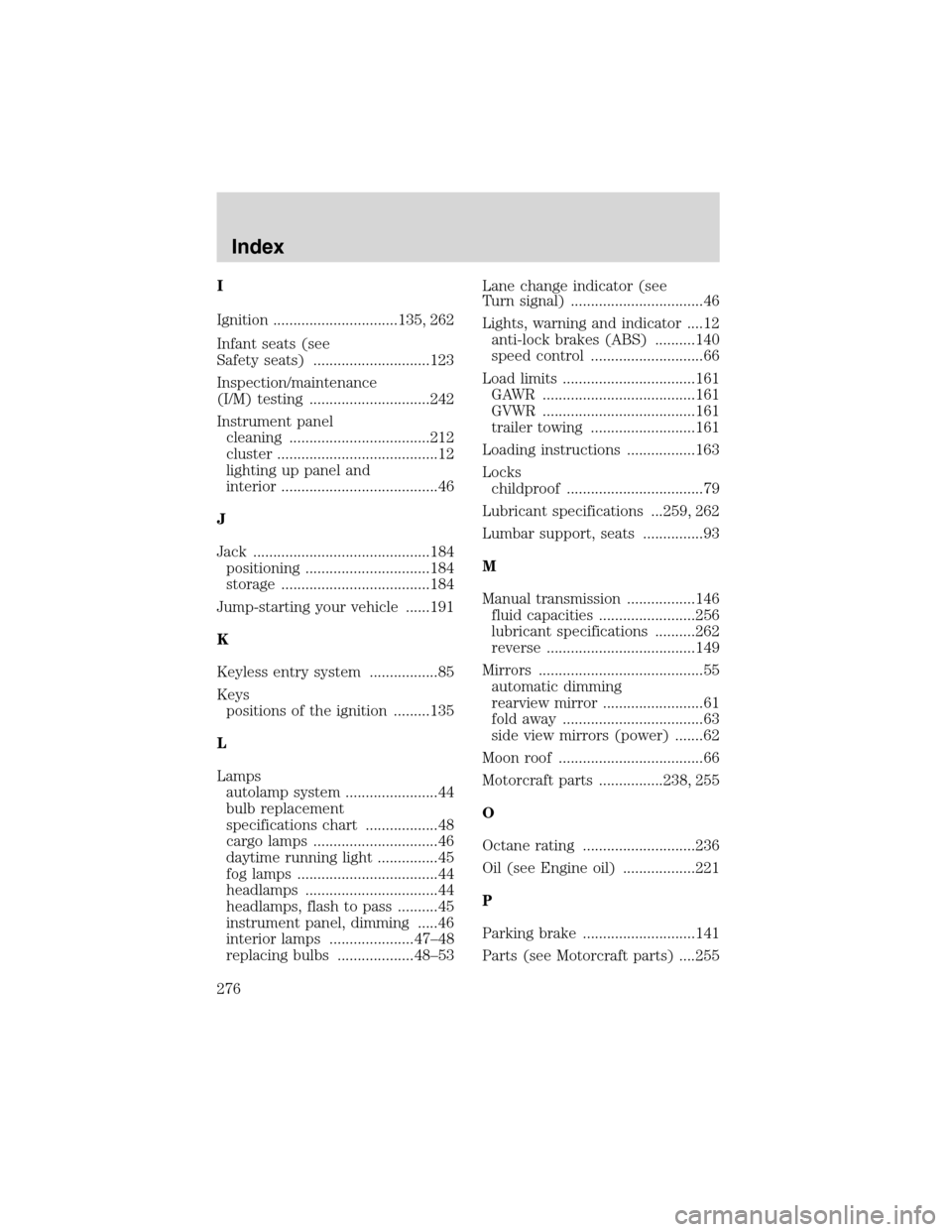2003 LINCOLN BLACKWOOD brake light
[x] Cancel search: brake lightPage 216 of 280

SERVICE RECOMMENDATIONS
To help you service your vehicle:
•We highlight do-it-yourself items in the engine compartment for easy
location.
•We provide a scheduled maintenance guide which makes tracking
routine service easy.
If your vehicle requires professional service, your dealership can provide
the necessary parts and service. Check yourWarranty Guide/Owner
Information Guideto find out which parts and services are covered.
Use only recommended fuels, lubricants, fluids and service parts
conforming to specifications. Motorcraft parts are designed and built to
provide the best performance in your vehicle.
PRECAUTIONS WHEN SERVICING YOUR VEHICLE
•Do not work on a hot engine.
•Make sure that nothing gets caught in moving parts.
•Do not work on a vehicle with the engine running in an enclosed
space, unless you are sure you have enough ventilation.
•Keep all open flames and other burning (cigarettes) material away
from the battery and all fuel related parts.
Working with the engine off
•Automatic transmission:
1. Set the parking brake and shift to P (Park).
2. Turn off the engine and remove the key.
3. Block the wheels.
•Manual transmission:
1. Set the parking brake, depress the clutch and place the gearshift in 1
(First).
2. Turn off the engine and remove the key.
3. Block the wheels.
Maintenance and Specifications
216
Page 226 of 280

Batteries normally produce explosive gases which can cause
personal injury. Therefore, do not allow flames, sparks or lighted
substances to come near the battery. When working near the battery,
always shield your face and protect your eyes. Always provide proper
ventilation.
When lifting a plastic-cased battery, excessive pressure on the
end walls could cause acid to flow through the vent caps,
resulting in personal injury and/or damage to the vehicle or battery.
Lift the battery with a battery carrier or with your hands on opposite
corners.
Keep batteries out of reach of children. Batteries contain sulfuric
acid. Avoid contact with skin, eyes or clothing. Shield your eyes
when working near the battery to protect against possible splashing of
acid solution. In case of acid contact with skin or eyes, flush
immediately with water for a minimum of 15 minutes and get prompt
medical attention. If acid is swallowed, call a physician immediately.
Battery posts, terminals and related accessories contain lead and
lead compounds.Wash hands after handling.
Because your vehicle’s engine is also electronically controlled by a
computer, some control conditions are maintained by power from the
battery. When the battery is disconnected or a new battery is installed,
the engine must relearn its idle and fuel trim strategy for optimum
driveability and performance. To begin this process:
1. With the vehicle at a complete stop, set the parking brake.
2. Put the gearshift in P (Park) (automatic transmission) or the neutral
position (manual transmission), turn off all accessories and start the
engine.
3. Run the engine until it reaches normal operating temperature.
4. Allow the engine to idle for at least one minute.
5. Turn the A/C on and allow the engine to idle for at least one minute.
6. Drive the vehicle to complete the relearning process.
•The vehicle may need to be driven 16 km (10 miles) or more to
relearn the idle and fuel trim strategy.
Maintenance and Specifications
226
Page 240 of 280

•Anticipate stopping; slowing down may eliminate the need to stop.
•Sudden or hard accelerations may reduce fuel economy.
•Slow down gradually.
•Driving at reasonable speeds (traveling at 88 km/h [55 mph] uses 15%
less fuel than traveling at 105 km/h [65 mph]).
•Revving the engine before turning it off may reduce fuel economy.
•Using the air conditioner or defroster may reduce fuel economy.
•You may want to turn off the speed control in hilly terrain if
unnecessary shifting between third and fourth gear occurs.
Unnecessary shifting of this type could result in reduced fuel
economy.
•Warming up a vehicle on cold mornings is not required and may
reduce fuel economy.
•Resting your foot on the brake pedal while driving may reduce fuel
economy.
•Combine errands and minimize stop-and-go driving.
Maintenance
•Keep tires properly inflated and use only recommended size.
•Operating a vehicle with the wheels out of alignment will reduce fuel
economy.
•Use recommended engine oil. Refer toLubricant specificationsin
this chapter.
•Perform all regularly scheduled maintenance items. Follow the
recommended maintenance schedule and owner maintenance checks
found in your vehicle scheduled maintenance guide.
Conditions
•Heavily loading a vehicle or towing a trailer may reduce fuel economy
at any speed.
•Carrying unnecessary weight may reduce fuel economy (approximately
0.4 km/L [1 mpg] is lost for every 180 kg [400 lb] of weight carried).
•Adding certain accessories to your vehicle (for example bug
deflectors, rollbars/light bars, running boards, ski/luggage racks) may
reduce fuel economy.
•To maximize the fuel economy, drive with the tonneau cover installed
(if equipped).
Maintenance and Specifications
240
Page 273 of 280

A
Accessory delay ..........................61
Air bag supplemental
restraint system ........................111
and child safety seats ............113
description ..............................111
disposal ....................................115
driver air bag ..........................113
indicator light .........................115
operation .................................113
passenger air bag ...................113
passenger deactivation
switch ......................................116
Air cleaner filter ...............250, 255
Air conditioning ..........................41
Ambulance packages ....................8
Antifreeze (see
Engine coolant) ........................227
Anti-lock brake system
(see Brakes) ..............................140
Armrests ......................................98
Audio system (see
Radio) ........................19, 25, 28, 31
Automatic transmission ............143
driving an automatic
overdrive .................................144
fluid, adding ............................245
fluid, checking ........................245
fluid, refill capacities ..............256
fluid, specification ..................262
Auxiliary power point .................59
Axle
lubricant
specifications ..................259, 262
refill capacities ........................256
traction lok ..............................142B
Battery .......................................225
acid, treating emergencies .....225
jumping a disabled battery ....191
maintenance-free ....................225
replacement, specifications ...255
servicing ..................................225
Bed extender ..............................73
BeltMinder .................................106
Brakes ........................................140
anti-lock ...................................140
anti-lock brake system
(ABS) warning light ...............140
fluid, checking and adding ....244
fluid, refill capacities ..............256
fluid, specifications .........259, 262
lubricant
specifications ..................259, 262
parking ....................................141
shift interlock ..........................143
Bulbs ............................................48
C
Calculating load ........................163
Capacities for refilling fluids ....256
Cassette tape player ...................28
CD-single premium .........19, 25, 31
Cell phone use ............................60
Certification Label ....................267
Changing a tire .........................184
Child safety restraints ..............120
child safety belts ....................120
Child safety seats ......................123
attaching with tether
straps .......................................128
in front seat ............................124
in rear seat ......................124, 127
Index
273
Page 276 of 280

I
Ignition ...............................135, 262
Infant seats (see
Safety seats) .............................123
Inspection/maintenance
(I/M) testing ..............................242
Instrument panel
cleaning ...................................212
cluster ........................................12
lighting up panel and
interior .......................................46
J
Jack ............................................184
positioning ...............................184
storage .....................................184
Jump-starting your vehicle ......191
K
Keyless entry system .................85
Keys
positions of the ignition .........135
L
Lamps
autolamp system .......................44
bulb replacement
specifications chart ..................48
cargo lamps ...............................46
daytime running light ...............45
fog lamps ...................................44
headlamps .................................44
headlamps, flash to pass ..........45
instrument panel, dimming .....46
interior lamps .....................47–48
replacing bulbs ...................48–53Lane change indicator (see
Turn signal) .................................46
Lights, warning and indicator ....12
anti-lock brakes (ABS) ..........140
speed control ............................66
Load limits .................................161
GAWR ......................................161
GVWR ......................................161
trailer towing ..........................161
Loading instructions .................163
Locks
childproof ..................................79
Lubricant specifications ...259, 262
Lumbar support, seats ...............93
M
Manual transmission .................146
fluid capacities ........................256
lubricant specifications ..........262
reverse .....................................149
Mirrors .........................................55
automatic dimming
rearview mirror .........................61
fold away ...................................63
side view mirrors (power) .......62
Moon roof ....................................66
Motorcraft parts ................238, 255
O
Octane rating ............................236
Oil (see Engine oil) ..................221
P
Parking brake ............................141
Parts (see Motorcraft parts) ....255
Index
276